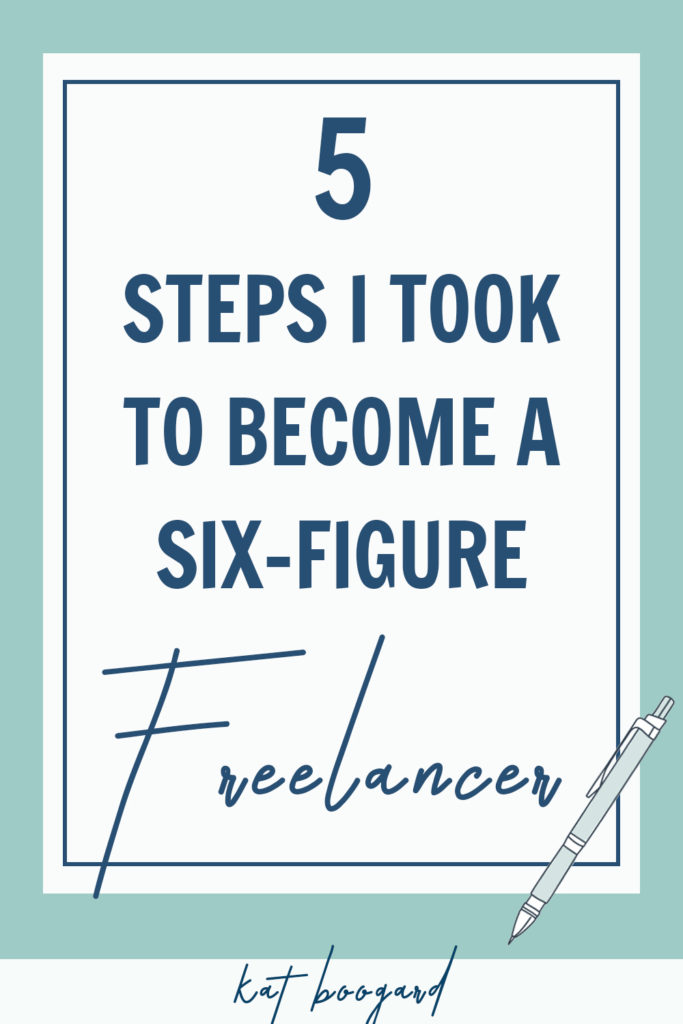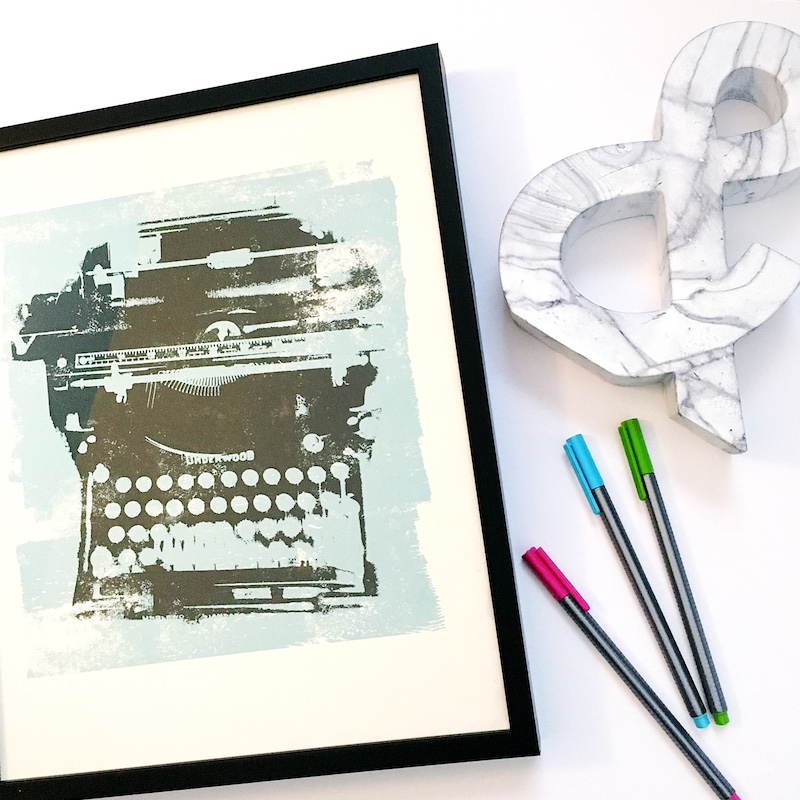5 Steps I Took to Become a Six-Figure Freelancer (Yes, Seriously)
Feb 12, 2018
Post updated: October 18, 2020

Can I be totally honest with you?
Even typing the phrase “six-figure freelancer” in this headline made me want to spit this vanilla latte all over the coffee shop I’m currently writing in.
Why? Well, for starters, it’s not a phrase I ever (I mean, ever) thought I’d use to describe myself. During my first full year as a freelancer, I was absolutely thrilled to earn just upwards of $30,000. I was doing what I loved and earning a respectable living while doing so. What a dream.
So, if you had told me that a few years from then I’d earn six figures? I would’ve laughed in your face. Seriously, I would’ve buckled over—teary-eyed from the hilarity of it all.
But, there’s another brutal reason the term “six-figure freelancer” inspires that cotton mouth feeling that accompanies nausea: It just sounds gross, slimy, and braggy, doesn’t it?
I see so many experts and online gurus use this tagline as a way to sucker in people who are just hoping to get started—as if freelancing is some get-rich-quick scheme that involves little to no effort.
Spoiler alert: That’s not the truth. Expect a lot of patience and elbow grease. I mean a lot. If you’re willing to invest the hard work, it is totally possible to rake in some cash as a freelancer. Here are a few steps I took to do just that.

My Friendly Disclaimer
I hope this goes without saying, but I couldn’t go without saying it.
The idea of sharing glimpses at my income online makes me clammy-palmed and nervous. Not because I’m weird about money (seriously, I couldn’t care less), but because I never want to seem like I’m gloating.
So, please know that I’m not sharing this to stroke my own ego. That’s not my intention. At all.
I remember all too well those many months spent toiling away for only a few dollars. My first year as a freelancer (granted, it was a half year—I started in July), I earned $5,300 for six months of back-busting work.
I get it. I really do.
Instead, I hope that this serves as inspiration for you. It’s totally possible to earn a great living for yourself as a freelancer, regardless of where you’re starting.
And, here’s the most important thing: I don’t believe you need to earn six figures in order to qualify as successful. Money isn’t everything. Take it from me—any amount that you earn from doing something you love is something that you should be so proud of!

How I Earned Six Figures as a Freelancer
Alright, with that out of the way, let’s get to the good stuff. What steps did I take to finally break that six-digit threshold in my freelance business? Here’s what you need to know.
1. I refined and expanded my freelance niche.
I’ve said it before and I’ll say it again: I think establishing a niche is crucial to gaining clarity as a freelancer. I’ll spare you from my same, tired spiel—you can find out everything you need to know about writing niches in particular in this post.
While I’ve been a big believer in the power of niches for quite some time, I’ll be the first to admit that I was pretty all over the place when I started my freelance career.
I wrote about storage unit insurance. I wrote about healthcare. I wrote about careers. Heck, I even wrote an entire piece about how fish finders work.
As a result, my reputation (not to mention my portfolio) was scattered and unfocused, and I struggled to land the opportunities I really wanted. Career websites just weren’t impressed by my storage unit writing samples.
I knew I needed to narrow things down. After writing a few career profiles for The Everygirl, I realized I loved talking about the world of work—and just like that, my niche was born.
I’ll warn you that this wasn’t an instantaneous transition. You don’t need to go all-in on your niche overnight.
Slowly but surely, I parted ways with those random assignments that weren’t a great fit for me and focused my pitching efforts on clients and opportunities that fell within my niche. I owe a lot of my success to this seemingly counterintuitive change.
Speaking of which, one of the biggest rebuttals I hear from other freelancers when it comes to niches is that they don’t want to limit themselves. I get that, and that’s why I recommend also identifying some sub-topics within your niche.
For example, as a freelance writer, my bread and butter is career advice. I write about how to land a job you love, as well as how to thrive in that role once you get it. However, that has naturally expanded to include things like:
- Productivity
- Entrepreneurship
- Project management
- Leadership
- Human resources
These things don’t detract from my career advice niche—in fact, you could argue that they all still fall under the career and world of work umbrella. Yet, they gave me numerous other outlets and opportunities (from project management software to productivity apps) I could pursue with my writing.
Yes, I still believe having a niche is important. But, don’t let that limit you to just one very specific topic or industry. Take the time to think about what other subjects would be a natural fit with your chosen focus area.
By thinking through all of the potential opportunities within your niche, you’ll open doors for yourself—without muddling your focus and your brand.
2. I dropped clients.
Wait… what?
I know what you’re thinking: How could dropping clients possibly lead to more income? Doesn’t more work = more moolah in the bank?
Here’s the thing: As I mentioned in my post on earning a living as a freelance writer, I earned just under $80,000 in 2016. But, in the interest of transparency, I worked day and night (uhh, and weekends) in order to do so. I ended that year feeling proud of that number, but also overworked and overwhelmed.
I knew I needed to change something. I couldn’t maintain that pace, no matter how much it inflated my bank account.
So, I took a good, hard look at all of the consistent work that I was doing. Seriously—I sat down with my dad and a notebook at Panera Bread and scribbled out:
- My current clients
- How many articles I was writing for them per month
- What that amounted to in terms of monthly income
That was a particularly revealing exercise. I realized there were quite a few regular assignments I was doing each month that I wasn’t excited about—and, even further, they weren’t paying me particularly well.
Do you know what I did then? I dropped them.
Of course, this isn’t to say that I eliminated everything that fell below a certain dollar amount—there’s a lot to be said for a gig that you love or even just contributes to your reputation.
But, anything that was particularly low-paying and I was okay parting with? I did so. Goodbye.
That freed up time that I could either use toward my personal passions and interests (I had honestly forgotten what those were for a while) or dedicate those newfound hours to existing, higher-paying clients who wanted more work from me—yet I hadn’t been able to accommodate with my full schedule.
The result? I worked way less in 2017 than I did in 2016, but I earned approximately $22,000 more. It’s crazy, but it’s true.
3. I focused on consistency.
You’ll hear a lot about the feast or famine phenomenon that comes along with freelancing. One week you’re buried under work, and the next week your inbox (and your fridge) is empty.
It’s an oft-repeated anecdote. However, that hasn’t been my personal experience—and that wasn’t by accident.
As opposed to completing random, one-off writing assignments for various clients, I typically try to pursue regular contributor agreements—where I’m submitting a set number of projects (articles or blog posts, in my case) per week or per month.
Not only does this help me maintain a realistic and predictable workload for myself, but it also leads to a far more reliable income.
So, if you have the option to become a regular contributor for an outlet—as opposed to just a sporadic freelancer—I highly recommend doing so.
Not sure how to go about that? Have no fear. I break down all of the details right here: How to Turn a One-Off Freelance Assignment into Consistent Writing Work
But, if you just want the highlights, I’ll give you a few quick bullet points. When you finish up an assignment for a one-off client, don’t just deliver your project and ride off into the sunset. Make it known that you’d like to continue working with them. A few ways to do that include:
- Recapping the different freelance services you offer.
- Pitching an idea for another valuable project you could produce.
- Straight-up asking about their upcoming freelance needs (don’t be shy!).

4. I became more aggressive with my rates.
Setting your rates is enough to make any freelancer break into a cold sweat. Even after years of freelancing, I still panic when somebody poses that dreaded, “So, what do you charge?” question. You think I’d be over it by now, but no such luck.
Even so, I’ve learned something important over the years: People aren’t going to give you something unless you ask for it.
As I’ve built up more of a reputation, I’ve become more comfortable quoting a higher price for new clients who were interested in working together.
Plus, when I don’t really need the work, I have the added safety net of knowing I’ll be fine if that client walked because of my rate. But, if they agreed? I would earn more (well-deserved, of course) for the same amount of work.
So, when you’re talking with a prospective new client, ask yourself how badly you need that project. Do you need that assignment to pay your bills or make your income goal for the month? Or is it frosting for you?
If it’s frosting, quote a higher rate. I’m talking the kind of rate that makes you wince behind your computer screen. If they walk, they walk. But if they sign on, you just gave yourself a major raise, my friend.
5. I worked my ass off.
Here’s the cold, hard truth: I may have finally achieved that six-figure benchmark that people go on and on about. But, there was no quick tip or hidden secret that helped me do that.
Ultimately, it just took a lot of hard work and patience.
2017 was the first year I cracked the six-figure milestone in my freelance business. That was my third full year as a freelance writer. That means that—at the end of 2017—I had been at this for three and a half years. It took me that amount of time to get what I earn now (and not 30 days like so many gurus and experts would have you believe).
You can absolutely earn a wonderful living as a freelance writer (I make way more now than I did when I worked a traditional full-time job!). But, it’s not something that’s just going to happen—it’s going to involve a lot of blood, sweat, and tears. You’re going to need to be willing to invest that.
Will I Always Earn Six Figures?
Will I earn six figures as a freelancer every single year? Maybe. But, then again, maybe not.
That’s the thing with freelancing—it can be sort of unpredictable. And, I’m okay with that. I’ve impressed myself with the amount I’ve been able to earn so far. But, I won’t be heartbroken if my income takes a dip every now and then. Money isn’t everything. Plus, those ups and downs are all part of the freelance rollercoaster ride.
As for you? Whether you’re closing in on six figures yourself or are still trying to figure out how to land a single paying gig (I’ve been there!), I’ll leave you with this nugget of inspiration: Freelancing is a rewarding and fulfilling career path—six figures or not. After all, it’s tough to put a price on doing what you love.
Got questions? Holler at your girl (that’s me—I’m your girl).